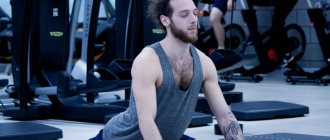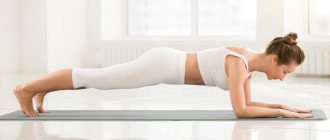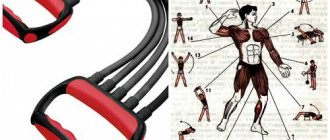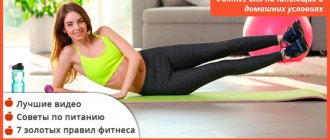Stretching after training (stretching) is a set of exercises aimed at developing the flexibility of all muscles of the body and joint mobility. Proper stretching will help avoid injuries, strengthen muscles, make them more flexible, become the key to correct posture and reduce pain after training.
Read: ways to get rid of muscle pain after exercise.
Stretching after a workout - instructions and tips
Why do you need stretching?
There are many reasons.
For example, oversized muscles are thought to interfere with normal movement, and bodybuilders are extremely inflexible to effectively stretch after strength training. However, this is nothing more than a myth - the smoothness and ease of movements does not depend on the volume of muscles.
Physiology of the process. Your muscles actively contract during cardio or strength training. After completing the workout, the loaded areas of the body remain clamped for a long time. The subsequent gradual restoration of muscle length is called rest. Until the muscle regains its length, it has not rested. To speed up the recovery process, it is most effective to apply a set of stretching exercises to all affected body groups.
Athletes begin to lose flexibility due to lack of appropriate regular exercise. Of course, some people are initially more flexible from childhood, but this is not an excuse. Stretching has a positive effect on any person - from children to the elderly. It is best to stretch regularly, performing special complexes, both before and after training or on rest days.

In addition, stretching in bodybuilding brings many benefits, for example, it perfectly warms up and calms the muscles, and also improves muscle coordination, prevents long-term muscle pain and speeds up recovery. You will feel more energetic and improve your body's capabilities.
Stretching after a workout at home
If you play sports not with a trainer, but on your own, then it is worth remembering a few rules that will protect you and maintain your health.
Basic Rules:
- Stretching after a good warm-up for 20-30 minutes.
- Do the exercises twice a day (morning and evening).
- Hold all poses for no more than 30 seconds.
- Do stretching in warm rooms. If this is not possible, then you should dress warmer.
- Perform all exercises regularly. Otherwise, you will quickly fall back in results.
Bodymaster.ru recommends Training Plans:
Stretching prevents stiffness. Over the years of training without high-quality regular stretching, the athlete’s muscles “remember” their shortened length and get used to it.
Muscle contraction and relaxation are two sides of the same process. As much as it can stretch, it can shrink further. If the muscle has not been stretched, it will contract less well, which will cause stagnation in strength results. We offer a simple set of exercises in a video program.
Also, stretching exercises prevent various injuries. According to statistics, athletes who regularly stretch are half as likely to suffer sprain-related injuries. If these professional guys take stretching responsibly, isn't it time for you to think about it too?
Tips for stretching muscles after a workout
During strength exercises, the muscles being trained shorten (compress). Immediately after their contraction, that is, after a working approach, the body tries to return them to their original state, to restore their former length. This process can last up to several days. Thus, an athlete who does not stretch his muscles after training delays the recovery process.
During training, we do not recommend that you stretch your muscles, simply because it relaxes them, instead of setting them up for work (for example, it is better to use warming ointments for these purposes), or simple shaking/twitching, or performing exercises with very light weights (including aerobic), which not only help to recover faster by removing metabolic products from the muscles (lactic acid), but also warm them up before the upcoming working approach.
And also, with regular stretching, the athlete will be able to lift much more weight, because as much as a muscle stretches, it contracts. This is extremely important for understanding the essence of stretching in order to increase strength, since the strength of the muscle fiber depends not only on strength the passage of a nerve impulse, but also on the amplitude of contraction (the greater it is, the greater the load the muscles will receive in the exercises).

Why do you need muscle stretching?
Thus, stretching will help the athlete:
- Increase strength indicators
- Build more muscle mass (due to an increased range of motion, as a result the muscles will be worked out better)
- Minimize tendon and ligament injuries in the gym
- Speed up the recovery process after training
- Improve blood circulation in the muscles, thus reducing soreness (delayed muscle pain after exercise)
- Relieve muscle tension
- Increase joint flexibility
- Give elasticity to the muscles (as a result, the amplitude of contractions will increase)
- Get rid of the “enslaved jock” complex
In addition, stiff, inflexible joints that have a shortened range of motion lead to inflammation and injury due to impaired biomechanics of movement.
The best list of exercises for stretching muscles after strength training in the gym.
Buttocks, back, oblique muscles
Lie on your back, stretch out, bend your left leg at the knee and smoothly, without rushing, begin to pull it towards your right side. In the extreme, taut position, hold the bent leg at the knee for a few seconds, feel a slight tension in the muscles and ligaments. Perform this exercise in 2 sets of 3 repetitions on each leg.
Remain lying on your back, straighten your right arm perpendicular to your body, begin to pull your leg bent at the knee with your left hand onto your right side and onto the floor, while watching your pelvis so that it does not completely roll over to the right side, otherwise this will have no effect. there will be no way to stretch the gluteal muscles. When performing the exercise, do not lift your head, shoulders and supporting arm from the floor.
Lying on your back, straighten your arms along your body, bend your knees, bring your feet together, relax.
Stay in this relaxed state for 1 minute, under the influence of gravity your muscles will stretch, as you train, reduce the distance between the pelvis and the turned out feet, and also to enhance the stretching effect, smoothly and without fanaticism, press your hands on your hips.
Spine
Spine
Lie on your stomach, pull your arms up to your head, lean on your forearms, so that your torso is slightly bent in the spine, at the angle you need. In this bent position, relax, hold for 20 seconds, feel a light, pleasant load in your lower back. Repeat this exercise 3-4 times.
While in the same position, pull your forearms towards your chest and shoulders, straighten your arms at the elbow joint, your back should arch, you will feel tension in the pelvis and lower back, relax them.
Spine
As you train, increase the angle of deviation of the torso from the horizontal, as well as the time the relaxed pelvis and lower back are under load.
This exercise helps in preventing a healthy spine.
While standing, lower the knee of your right leg to the floor, while the knee of your right leg should be pushed forward.
Make sure that your right knee, shoulder, and hip joint are in line. Adjust the degree of tension in the front of your right thigh by moving your pelvis forward.
Do 5-10 swings for one leg.
To perform this exercise you will need a Swedish ladder. Raise your right leg to the required height, while the left leg, like the right, should be fully straightened at the knee.
Do 10-15 swings towards the foot of your right leg. Make sure that the left leg is fully straightened at the knee joint, and the direction of the knee should coincide with the direction of the foot. As you train, increase the height of the leg lift, as well as the amplitude of the swings.
A fairly common exercise when a person sits on the floor, with his legs straightened at the knees, and performs smoothly rhythmic bends of the torso towards the toes. You may mistakenly think that this exercise stretches the hamstrings, but in reality it is aimed at improving the flexibility of the spine.
Find a support, rest your left hand on it so that your body is completely straight, bend your left leg at the knee, and with your right hand grab your left ankle and pull it up.
With practice, you will learn to pull your heel towards your buttocks, but do not strive to develop extreme flexibility in this exercise, due to the fact that there is a high probability of stretching the knee tendon. Switch legs and repeat the exercise.
Keep in mind that beginners in this exercise often confuse the order of actions: the left ankle is pulled up with the left hand, and vice versa, the right ankle is pulled up with the right hand.
And this, in turn, has a destructive effect on the knee joint due to the unnatural bend.
To perform this exercise more safely, do the same thing only while lying down.
Spine, back, neck, shoulders
Find a chair or something similar, such as a bench with a back, and sit sideways to the back. Holding your pelvis and legs, make a motionless turn with your torso, point your shoulders and head in the same direction, apply the necessary forces to the back of the chair for a stretching effect, stay in this position for a couple of seconds.
Sit on the other side and repeat this exercise. The increase in the amplitude of the stretching movement should occur smoothly and gradually.
Sit on a chair, straighten your back, look straight ahead.
In this position, tilt your chin down and turn your head first in one direction, then in the other, slightly helping with your hand to ensure the desired stretch of the neck.
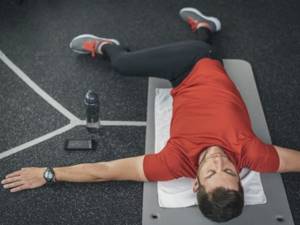
Do 3-4 reps on each side.
Legs and lower back
Sit on the cards, with both hands press first on your right knee, then on your left knee, imagine as if you want to remove the weight from your knees with your hands.
In this simple way, you can achieve full amplitude bending of your knees, and this in turn will keep them healthy.
Legs and lower back
Squat down so that your buttocks touch the floor. Hold the lower position for 20 seconds and stand up.
Perform 2 sets of 2 reps. This exercise puts quite a lot of stress on the knee joint, so it is recommended that you first help yourself with your hands at the lowest point.
Shoulders and chest
To complete this exercise you will need a doorway, or something similar to it. Approach so that your socks are at a distance of 7-8 cm from the doorway and rest your bent arms against the wall or door frames, as shown in the figure.
Shoulders and chest
The optimal angle of flexion at the elbow joint is about 90-100 degrees, make sure that your shoulders are parallel to the floor. As you lean your body forward, you will experience a slight stretch in your shoulders and chest.
In order to progress in this exercise, you need to stand up each time a little further from the doorway, while your hands should remain in the same place, thus, when you bend forward, you will experience more and more tension in the shoulder girdle.
Do this exercise with caution to avoid straining your pectoral and shoulder muscles.
Achilles tendons
Find a step of the required height to perform the exercise in full amplitude. Place your right foot on the step and shift your body weight; only the front of your foot should be on the step. Slowly lower your heel and you will feel the Achilles tendon stretch. Change your leg.
We need flexible Achilles tendons so that we can squat in regular shoes, with a normal heel, without the need to place weights or other objects under the heel.
Hang on the bar, grip shoulder-width apart, you should relax your lower body and feel your vertebrae straighten, fatigue leaving your lower back.
Spine
Do not jump off the bar abruptly, you may injure your spine.
Be sure to perform this exercise after heavy, compound exercises such as deadlifts and squats, and indeed after any other exercises that place significant compressive load on the spine.
If you want to stretch your spine at different angles, then simply raise your knees to waist level and smoothly rotate your hips.
Spine
Find two pillows, lie on the floor and place them under your pelvis, while relaxing your lower back as much as possible, lie there for about 1 minute. When performing the exercise correctly, you will feel a release in the lumbar region.
When you finish doing this exercise, do not lift your torso, you can easily injure your spine, just roll onto your side and stand up.
Shoulders, arms and chest
Shoulders, arms and chest
Twists are an exercise for those who want to hold the barbell as low as possible on the trapezius during squats.
With both hands, take a stick or towel, as shown in the figure, place your feet shoulder-width apart, straight back, begin to raise your straightened arms at the elbows above your head and lower them behind your head as low as possible, this will count as one repetition.
Shoulders, arms and chest
When to do stretching exercises
It is best to stretch the muscles after a short warm-up or workout, when they are well warmed up or too tired to resist stretching.
Make it a rule to do the suggested exercises after every strength or cardio workout. Weight training makes muscles hard and inflexible. When working with heavy weights, micro-tears of muscle fibers occur. Within 24-73 hours after training, the body restores them, causing them to become stronger and fuller. By performing appropriate recovery exercises on the day of your workout, you will loosen your muscles and also develop flexibility (provided you do it long enough and often enough).

You can stretch at home in the evening after training. For many active athletes, this is an ideal option, as it does not require special equipment. The more you stretch throughout the day, the more flexible your muscles will be and the easier it will be for you to maintain flexibility in the future.
Basic set of exercises
The main elements of body stretching for beginners after strength training should be the following:
- It is better to start stretching while sitting. Spreading your legs as wide as possible, you need to reach for each toe in turn.
- The next element should be this: from the same position, you need to bend one leg at the knee and reach with your hands to the toe of the second leg.
- From the “sitting on your knees, resting your buttocks on your heels” position, slowly bend forward.
- We stand on our feet, placing them shoulder-width apart. We cross our arms behind our backs. Bringing the same arm and leg forward, we make a wide lunge and spring on the leg for 15 seconds. We change sides.
Men and women need to add a number of elements to the set of exercises, which are presented in the table.
| Man | Woman |
| From a standing position, we extend our right arm to the side, grabbing the left toe of the foot and pressing it to the buttock. Delay 10-15 seconds. Change of legs. | We stand on our feet and place our palms on our heads. We bend the neck back and forth. |
| Side lunges. | We clasp our hands behind our backs and stretch them as far as possible until we feel pain. |
| We kneel down and lean forward, maintaining balance. Ideally, your forehead should touch the floor. | We take the elbow of the opposite hand with our palm behind our back and pull it until we feel pain in the joints. Change of hands. |
| We stand on the bridge from a lying position. |
We complete the complex with two elements:
- we sit on the floor and bring our legs together, slowly bend towards our toes;
- We spread our legs to the sides and lean forward, sliding our palms along the floor.
This stretching can be done after every strength or cardio workout. Exercises in the gym require deeper muscle development, which needs to be devoted to at least 30-40 minutes. In this case, it is necessary to consistently stretch all muscle groups: from the neck to the legs.
Bodymaster.ru recommends Fitness Trainers:
Stretching exercises after training are done statically without sudden body swaying or jerking.
After a delay in the working position, when the muscles have become accustomed to the position of the body, you can begin progressive stretching. From a position of light stretching, you need to gradually move forward until you again feel a slight stretch in the muscle. Hold again for 10-30 seconds. The voltage will decrease slightly. Again, if you feel discomfort or pain in your muscles, you need to ease up to the point of comfort.
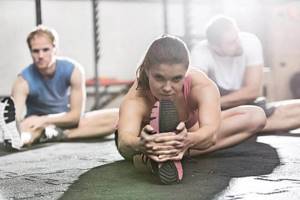
Remember to breathe. Breathe naturally while doing the exercises. Do not hold your breath, as this interferes with relaxation and is not beneficial. To avoid sudden movements that cause contraction of muscle fibers, breathe slowly and rhythmically. The exhalation force helps to better relax the muscle and enhances the effect. Additionally, try exercises with a massage roller. They will become indispensable for a deeper study of the fascia.
Incorrect technique
Discomfort or pain means you are stretching incorrectly, such as springing. The body responds better when completely relaxed. Pain and discomfort cause tension. It is better not to stretch through the pain, this can lead to rupture.
Is stretching necessary after strength training?
Many people, especially men who come to the gym to “pump up”, consider stretching to be the domain of ballerina girls and refined fifas. Well, there are those girls and women who consider static muscle stretching to be boring and uninteresting, which is why they go to strength training.
Both of them are greatly mistaken.
Weight training causes muscles to become rigid and inflexible. When you lift heavy weights, micro-tears in the fibers occur. It will take 1-5 days to restore them. And with stretching, things will go faster, and besides, the muscles seem to “loose up.”
For bodybuilders, stretching helps:
- warm up the muscles
- calm them down
- improve muscle coordination,
- prevent delayed pain,
- speed up recovery,
- gain calm and stress resistance - yes, yes, you heard right,
- receive half as many injuries associated with sprained ligaments and muscles.
Muscle stretching after training for bodybuilders should take place in a gentle tension position for 10-30 seconds. You shouldn't feel any pain!

After this, you can move on to progressive stretching - move until you feel a slight stretch. Find your point of comfort; there should be no unpleasant sensations. Everything that has just been said applies not only to those who engage in strength training, but for bodybuilders I would like to say this separately because they are accustomed to overcoming pain and setting some kind of records.
So, stretching is not the time for painful achievements, remember this.
And now the portal hudeem-bez-problem.ru will tell you the general principles of how to stretch after a workout and offer you several techniques.
To begin, remember two important principles:
- When stretching, maximum attention is paid to those muscles that were involved in the training;
- breathe correctly - without delay, rhythmically, slowly, with full inhalations and exhalations; stretch the muscle as you exhale, as this helps relax it more.
Leg stretching complex
Gluteal stretch
- 10-20 seconds
- Body Part: Buttocks Equipment: No
Glute stretch (knee to chest)
- 10-20 seconds
- Body Part: Buttocks Equipment: No
Hip abductor stretch while lying on the floor
- 10-20 seconds
- Body Part: Hamstring Equipment: No
Quadriceps stretch while sitting on your knees
- 10-20 seconds
- Body part: Quadriceps Equipment: Body weight
Quadriceps stretch while kneeling
- 10-20 seconds
- Body part: Quadriceps Equipment: Body weight
Quadriceps Lunge Stretch
- 10-20 seconds
- Body part: Quadriceps Equipment: Body weight
Forward Bend Hamstring Stretch
- 10-20 seconds
- Body Part: Hamstring Equipment: No
Stretch your calf muscles with your palms against the wall
- 10-20 seconds
- Body Part: Calves Equipment: No
Stretching the calf muscles and Achilles tendon
- 10-20 seconds
- Body Part: Calves Equipment: No
Add to Calendar * Add to My Workouts * Print Workout
* — The service is in beta testing
Pay attention to the results: how do your muscle fibers feel, have they begun to recover better and faster?
Options
Most post-workout stretches do not require weights or machines. Therefore, they can be performed both in the gym and at home. When choosing a complex, first of all, focus on the nature of your training.
Stretching after strength training for girls
Girls need static stretching of their muscles so that they do not become too pumped and look natural.
- Neck
Stand up straight. Place your arms bent at the elbows behind your back. At the level of the lower back, clasp your fingers around the wrist of the other. Pull them to the side, taking your shoulder and neck with you. Fix at the maximum tension point. Return. Repeat for the other side.
- Breast
Stand straight in the doorway. Knees slightly bent. Raise your arm bent at the elbow to shoulder level and move it to the side to rest it on the doorframe. Slowly turn your body in the opposite direction. Fix at the maximum tension point. Return. Repeat for the other side. This stretching of the pectoral muscles will allow girls to have a beautiful breast shape.

Stretching exercise options
- Shoulders
Get on your knees and clasp the fitball with your hands. Lower your buttocks onto your heels, straightening your arms at the elbows. The back and head are straightened, resembling a stretched string. You cannot lie on your stomach on the floor. Fix at the maximum tension point. Return.
- Hands
Sit on the fitball. The back is straight. Feet firmly on the floor. Place your right hand on your left knee. Stretch the left one as much as possible, raise it above your head and begin to pull it to the right. Fix at the maximum tension point. Return. Repeat for the other side. This exercise is not only for the arms, but also for the abs.
- Back
Lie on your stomach on a fitball, resting the fingers of all limbs on the floor. First relax. Then tense your abdominal muscles, pulling your stomach in (as when doing the “vacuum” exercise). Arch your back up. Fix at the maximum tension point. Return.
- Stomach
Lie down on the floor. Knees bent, feet pressed firmly to the floor. Hands are spread out in different directions. Slowly turn both legs to the side and try to place them on the floor. Fix at the maximum tension point. Head, shoulders, shoulder blades - the entire upper body remains motionless. Only the abdominal muscles curl. Return. Repeat for the other side.
The last three exercises in this complex are stretches of the legs and buttocks, which are recommended for all women to perform after strength training.
- Buttocks
Lie down on the floor. Knees bent, feet pressed firmly to the floor. Place your right shin behind your left knee. Grab your left thigh with both hands and pull it towards you. Fix at the maximum tension point. Return. Repeat for the other side. Stretching the gluteal muscles after strength training is simply necessary for girls so that they are not pumped up and at the same time acquire a beautiful shape.
- Hips
Sit on the floor. Place a rubber expander over your right foot (it should go straight through the middle). Having pulled it with both hands, lie on your back. Raise your right leg vertically up, straightening your knee. Pull the expander over yourself. Fix at the maximum tension point. Return. Repeat for the other thigh.
- Caviar
Stand facing the wall, feet shoulder-width apart, palms resting on the wall. Place your left leg slightly forward and bend at the knee. Place the right one far back, straightening it, but so that the entire foot rests firmly on the floor. Bend your left knee more strongly. Feel the tension in your right calf, but do not lift your heel off the floor. Fix at the maximum tension point. Return. Repeat for the other caviar.
Stretching the entire body (from the neck to the calves) ensures that the muscles recover quickly.
Stretching after strength training for men
A properly selected post-workout set of exercises will allow men to improve the results of strength training and quickly build muscle mass. PNF or active-isolating options will be especially useful.
- Neck
Stand up straight. Tilt your head to the right. Place your right palm on top of your head and press lightly, increasing the tilt of your head to the side. Fixation for no more than 20 seconds. Take the starting position. Do it for the opposite side.
- Breast
Lean on the bars with your elbows bent. Feet firmly on the floor. Begin to slowly lower yourself down as far as your chest will allow. Feel the point of maximum tension. Fixation for no more than 20 seconds. Take the starting position.
- Biceps
Stand with your right side against the wall. Move your right hand slightly back and to the side. Press her fingers against the wall. Start slowly turning to the left. Feel the point of maximum tension. Fixation for no more than 20 seconds. Take the starting position. Do it for the opposite side.
- Triceps
Stand up straight. Bend your left arm at the elbow, place it behind your back from above, from the side of your head. With your right hand, take your left elbow and begin to slowly pull it to the right and down. Feel the point of maximum tension. Fixation for no more than 20 seconds. Take the starting position. Do it for the opposite side. Great triceps stretch to increase muscle mass in your arms.
- Back
Lie on your right side, bend your right knee and bring it out in front of you. The left leg is pulled back, straightened and stretched. Raise your arms above your head. Stretch all your muscles: arms up, left leg down. Fixation for no more than 20 seconds. Take the starting position. Do it for the opposite side. This is a stretch for the latissimus dorsi muscles, so as not to pull them when lifting a barbell, for example.
- Press
Lie on your back. Clasp your hands behind your head. Knees bent, feet firmly on the floor. Raise your head and upper body, bringing your right elbow toward your left hip as if doing a side crunch. Feel the point of maximum tension. Fixation for no more than 20 seconds. Take the starting position. Do it for the opposite side.
- Quadriceps
Get on your knees, with as much distance between them as possible. Hold your feet with your hands and spread them apart. Slowly lean back as far as your body flexibility allows. Ideally, lie on the floor between your calves. Fixation for no more than 20 seconds. Take the starting position. Men can try a few more exercises for the quadriceps: frog, blue, back lunges.
In addition to accelerating muscle growth, good stretching can reduce the risk of overtraining and further prevent injury.
After cardio training
Suitable for both women and men. Since cardio training most often aims to strengthen the cardiovascular system and lose weight, it is best to include dynamic or ballistic stretching in the post-workout complex:
- swings;
- lunges;
- bends;
- scissors;
- bridge;
- compass;
- abdominal exercises
Stretching exercises are an excellent cool-down option after any workout - men's and women's, strength and cardio, short and long, in the gym and at home, for building muscle and losing weight. There is no training after which it would not be useful. So study, master and improve your body with its help ad infinitum.
Stretching for splits after training
And the last issue that should be discussed is contraindications.
- injuries of inguinal ligaments and tendons;
- serious problems with the spine;
- acute inflammatory processes of the musculoskeletal system.
If you do not have the above problems, then feel free to do the splits, because this exercise:
- stimulates the functioning of internal organs;
- improves blood circulation;
- relieves tension;
- develops flexibility.
